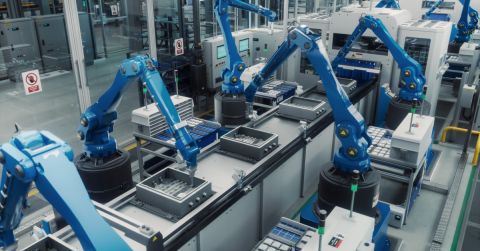Audio DACs Convert Bits Into Music

Digital-to-analog converters (DAC) are integrated circuits that translate digital signals into analog signals. The converters do this by scaling a defined analog range for output with a predetermined number of digital bits as input. For each pulse of the clock, a new value is converted. The analog output is sent downstream, and for audio, usually into a speaker or other listening device.
DACs may perform the conversion in either a parallel or a serial mode. Typical communication protocols used with DACs are I2C, I2S, and SPI. The protocols are widely used and make the DACs compatible with many interfacing controllers and microprocessors. Along with communication protocols comes sampling rates so each bit, or parallel bytes, may be measured and processed during operation.
Basic Operation of D/A Converter
Accuracy of the conversion is determined by the resolution available. Resolution is determined by the number of digital input bits and analog output range. As the analog range will be scaled by the bits, it is best to use as many bits as is practical for your conversion.
System resolution desired for the conversion will determine number of input bits required. Upstream devices included in the system such as audio deliver a given set of bits. As an example, if there are 3 bits available, there would be 23 = 8 scaled analog outputs available. Given a 3.3V analog output range, each bit would represent a scaled analog value of 0.4125V. If 8 bits are available, there are now 28 = 256 scaled analog outputs available within the same analog range of 3.3V. Each bit now represents 0.013V giving your converter the ability to remove error when moving from sample to sample.
 Wide digital bits create a choppy analog sine wave
Wide digital bits create a choppy analog sine wave
Resolution is also dependent on sampling rate. Sound happens quickly and the DAC’s ability to keep up with the data fluidly being presented at its inputs is key to producing details of the sound. Many DACs come with programmable sampling rates to enable ability to read the upstream device.
There are additional characteristics defining D/A converters and a few are defined below.
D/A: Digital-to-Analog.
DAC: Digital-to-Analog Converter.
Differential outputs: Differential signaling is a method for electrically transmitting information using two complementary signals, alleviating common-mode noise.
Dynamic range: The range of acceptable or possible volumes of sound occurring in the course of a piece of music or other sounds.
I2C: Inter-Integrated Circuit is a synchronous, multi-master, multi-slave, packet switched, single-ended, serial computer bus used for attaching lower-speed peripheral ICs to processors and microcontrollers.
I2S: Inter-IC Sound is an electrical serial bus interface standard used for connecting digital audio devices together.
PCM: Pulse-code modulation is a method used to digitally represent sampled analog signals.
Sampling rate: The number of samples of audio carried per second, measured in Hertz (Hz).
Single-ended outputs: Single-ended outputs are signals carried on one net referenced to ground or other designated signal.
SPDIF: Sony/Philips Digital Interface is a type of digital audio interconnect used in consumer audio equipment to output audio over reasonably short distances.
SPI: Serial Peripheral Interface is a synchronous serial communication interface specification used for short distance communication.
THD: Total harmonic distortion is a measurement of the harmonic distortion present in a signal and is defined as the ratio of the sum of the powers of all harmonic components to the power of the fundamental frequency.
TDM: Time Domain Multiplexed is a method of transmitting and receiving independent signals over a common signal path by means of synchronized switches at end of the transmission line.
 DACs take digital sound information and convert it into analog sound waves
DACs take digital sound information and convert it into analog sound waves
Parts to Consider for Use in D/A Audio Conversion
We now take a look at three parts you may want to consider for audio conversion.
Analog Devices, ADAU1966A
This is a D/A converter suitable for audio applications with ability for 16 digital inputs supporting 24-bit resolution as either a standalone or as a slave for communication with a microprocessor. When used with a microprocessor, the DAC offers either I2C or SPI bus protocols for communication. The channels are differential for improved noise mitigation and distortion performance. The part has configuration options to support selectable channels up to 16.
The ADAU1966A is a high performance, single-chip digital-to-analog converter (DAC) that provides 16 DACs with differential or single-ended outputs using the Analog Devices, Inc., patented multibit sigma-delta (𝚺-Δ) architecture. A serial peripheral interface (SPI)/I2C port is included, allowing a microcontroller to adjust volume and many other parameters. The ADAU1966A operates from 2.5V digital and 3.3V analog supplies. A linear regulator is included to generate the digital supply voltage from the analog supply voltage. The ADAU1966A is available in an 80-lead LQFP.
The ADAU1966A is designed for low EMI. This consideration is apparent in both the system and circuit design architectures. By using the on-board PLL to derive the internal master clock from an external left-right frame clock (LRCLK), the ADAU1966A can eliminate the need for a separate high frequency master clock and can be used with or without a bit clock. The DACs are designed using the latest Analog Devices continuous time architectures to further minimize EMI. By using 2.5V digital supplies, power consumption is minimized, and the digital waveforms are smaller amplitude, further reducing emissions.
 ADAU1966A Functional block diagram
ADAU1966A Functional block diagram
The ADAU1966A is qualified for automotive applications making it suitable for automotive audio systems. It may also be used for home theatre systems and for use with digital audio effects processors.
In addition, Analog Devices offers an Evaluation Board and User Guide, UG-564, for use with this part, the EVAL-ADAU1966AZ, The guide walks you through the design and setup including connection to a 12VDC power supply, control via either I2C or SPI bus interface protocols, and options for connecting the evaluation board to a PC USB port. It includes a graphical user interface (GUI) program that enables direct access to the DAC’s registers, and it has analog outputs accessible via eight stereo TRS mini jacks. A function block diagram is below:
 EVAL-ADAU1966A functional block diagram
EVAL-ADAU1966A functional block diagram
Texas Instruments, PCM1794A
This is a D/A converter suitable for audio applications with ability for standard, or I2C, data format for serial communication. This part supports differential pairs and outputs stereo to a left and right channel. It is suitable for communication with a microprocessor via the I2C bus.
The PCM1794A device is a monolithic, CMOS-integrated circuit that includes stereo digital-to-analog converters (DACs) and support circuitry in a small 28-pin SSOP package. The data converters use TI’s advanced segment DAC architecture to achieve excellent dynamic performance and improved tolerance to clock jitter. The PCM1794A device provides balanced current outputs, allowing the user to optimize analog performance externally. Sampling rates up to 200kHz are supported.
 TI’s PCM1794A simplified block diagram
TI’s PCM1794A simplified block diagram
The PCM1794A is good for use in car audio systems. It may also be used with A/V receivers, in DVD players, in musical instruments, and in other applications requiring 24-bit audio.
STMicroelectronics, STA310
This is a D/A converter for audio applications capable of decoding Dolby Digital, MPEG, MPEG-2, MP3, Karaoke, Prologic, and Downmix for Dolby Prologic. Its control interface supports 8-bit parallel interface or communication serially via I2C. Its input data is capable of either parallel or serial input. This part has an internal PLL to configure the clocks and it supports 1 to 8 channels.
The STA310 is a fully integrated Audio Decoder capable of decoding all the above listed formats. Encoded input data can be entered either by a serial (I2S or SPDIF) or a parallel interface. A second input data stream (I2S) is available for micro input. The control interface can be either I2C or a parallel 8-bit interface. No external DRAM is necessary for a total of 35ms surround delays.
 ST Microelectronics STA310 block diagram
ST Microelectronics STA310 block diagram
The STA310 works well for high-end audio equipment, in DVD consumer players, in set-top boxes, for HDTV, and for your PC’s multimedia needs.
DACs are used in mixed signal systems to collect audio information digitally for conversion to analog sound output. Many vendors make DACs for sound production and the parts come with a variety of features. With selectable features, the part for your specific application may be found. OctoPart can help you find the right DAC for your sound needs.
Stay up-to-date with our latest articles by signing up for our newsletter.








